The AAS Astronomy Ambassadors Program
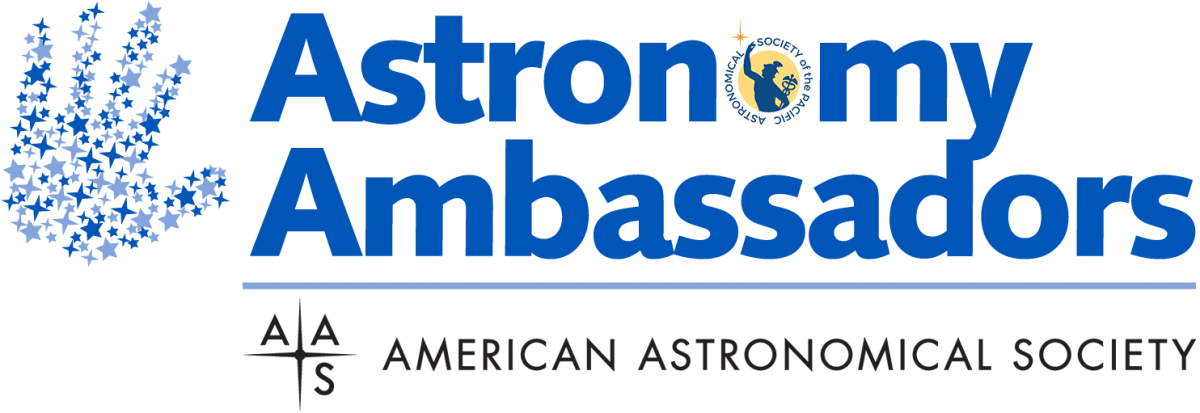
For early-career AAS members interested in, or already, doing outreach with students and the public, the AAS Astronomy Ambassadors program provides professional development and mentoring opportunities, through workshops at AAS meetings, an online community of practice, and access to resources and contacts.
Working in partnership with the Astronomical Society of the Pacific (ASP), National Radio Astronomy Observatory, and the Portal to the Public/Institute for Learning Innovation, the AAS Astronomy Ambassadors program targets early-career astronomers, including graduate students, postdocs, relatively new faculty, and advanced undergrads.
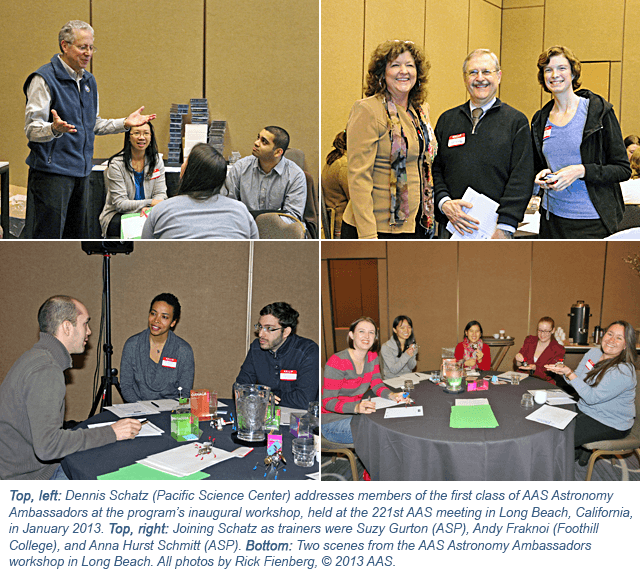
By learning how to implement effective education and outreach strategies, AAS Astronomy Ambassadors will become better educators, better presenters at meetings, and better representatives of our science to the public and to government. And because young astronomers are a more diverse group than those who currently do the majority of outreach, they help the astronomical community present a more multicultural and gender-balanced face to the public and enable members of underserved groups to see themselves as scientists.
Since “random acts of EPO” have been shown to have no lasting effect, the emphasis of the AAS Astronomy Ambassadors program will be on helping participants set up ongoing, sustainable partnerships with schools or other organizations.
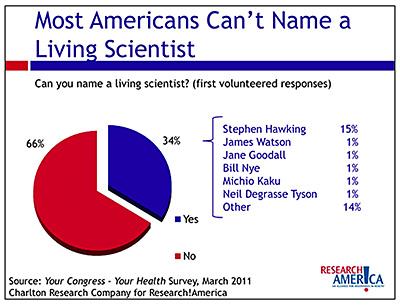
Putting a Face on Science
The Astronomy Ambassadors project was the brainchild of then-AAS President Debra M. Elmegreen. Among other motivations, she was alarmed at the results of Research!America’s 2009 “Your Congress–Your Health” poll, in which 65% of Americans said they couldn’t name a living scientist and another 18% tried but failed, either naming dead scientists or nonscientists. In other words, the poll showed that fewer than 1 in 5 Americans can name a living scientist; undoubtedly, the fraction of our citizens who know a scientist personally must be far smaller. The AAS Council agreed with Elmegreen that we should take action to address this problem.
The AAS mission statement includes two key statements that explains why the Society is investing in communication and outreach training:
- The Society, through its members, trains, mentors, and supports the next generation of astronomers. The Society supports and promotes increased participation of historically underrepresented groups in astronomy.
- The Society assists its members to develop their skills in the fields of education and public outreach at all levels. The Society promotes broad interest in astronomy, which enhances science literacy and leads many to careers in science and engineering.
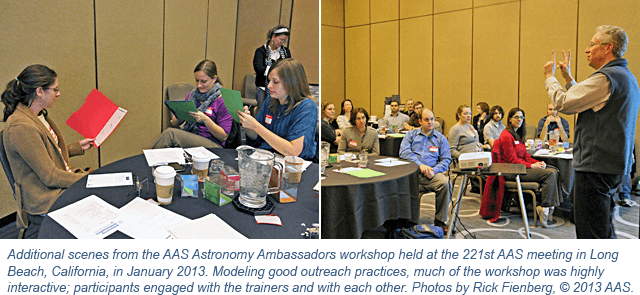
The first Astronomy Ambassadors workshop was held at the 221st AAS meeting in Long Beach, California, in January 2013 and served 30 young astronomers chosen from more than 75 applicants. A professional evaluation of the workshop was conducted via pre- and post-workshop surveys, observations of the workshop, lunchtime focus groups, and later telephone interviews with a subset of participants. More than 90% of respondents rated the inaugural workshop good or excellent. Feedback from participants and lessons learned from their outreach event logs helped inform planning for subsequent workshops, which have been held at every winter AAS meeting since.
Who Are the AAS Astronomy Ambassadors?
One of our goals is to put a young, enthusiastic, and diverse face on the science of astronomy. Accordingly, the primary candidates for Astronomy Ambassadors training are early-career AAS members: mainly graduate students and first-time postdocs, but also some advanced undergraduate seniors as well as new faculty members.
We strive to include ambassadors of diverse gender, racial, and cultural backgrounds; from institutions large and small and urban and rural; from throughout North America; and to encourage ambassadors to seek out venues with diverse audiences for their outreach activities. The information in the following graphics is drawn from the applications of the first two classes of AAS Astronomy Ambassadors (60 people):
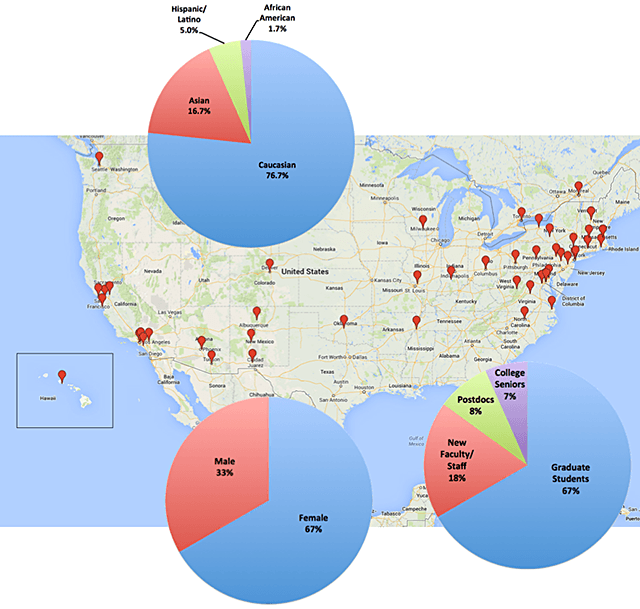
As of mid-2014, 42 (70%) of the first two cohorts of ambassadors had logged a combined 207 EPO events, while 18 (30%) had not yet logged their first event. The five most active ambassadors had, between them, logged 103 events, i.e., half the total. Seventeen more ambassadors had logged at least three events, while 20 had logged one or two events each. More events are logged every week.
Whom Are Ambassadors Serving?
The opportunities for outreach are many, both in and out of the classroom. Adults and family groups flock to community centers, science museums, planetariums, nature centers, national and regional parks, fairs and festivals, science-institution open houses, etc., where they can be engaged in science, technology, engineering, and mathematics (STEM) activities. And students can be found not only in formal classrooms, but also in afterschool programs and summer camps. The tools emphasized in the workshop are most appropriate for the general public and middle- and high-school students. Based on our Ambassadors' event logs, the average audience is about 75 people ranging from preschoolers to senior citizens, with most events serving K- 12 schoolchildren and their parents and teachers.
A Community of Practice
Using infrastructure already developed for the ASP's Astronomy from the Ground Up (AFGU) program, we've built a forum dedicated to tools for, and communication among, Astronomy Ambassadors. Participants are part of an online community that regularly exchanges ideas, resources, and experiences, not only with each other but also with their workshop trainers.
As the program grows — as new cohorts of Ambassadors "graduate" from training and get involved with outreach — there will be an increasing number of participants in the online forum and more opportunities for sharing of successes and challenges and for group problem solving.
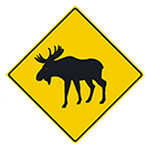 The MOOSE: A New Resource for Astronomy EPO
The MOOSE: A New Resource for Astronomy EPO
AAS Astronomy Ambassadors are provided with a large library of outreach activities and materials that are suitable for a range of venues and audiences and that grows with time. We call it the MOOSE, or Menu of Outreach Opportunities for Science Education, and we have posted it online for the benefit of the larger astronomical community.
For much of the MOOSE we are using resources developed by the ASP, the Pacific Science Center, and the Center for Astronomy Education for their outreach programs, though some resources have been created by Andy Fraknoi specifically for the Astronomy Ambassadors program.
How Can You Become Involved?
If you’re part of our target audience to become an Astronomy Ambassador, please watch the AAS website for announcements of future workshops.
Apply to Participate at AAS 239, Salt Lake City, UT, January 2022
If you’re an experienced EPO professional and are interested in contributing outreach materials or techniques that you have developed and that could be featured on the Astronomy Ambassadors website and/or our workshops, please contact Linda Shore, ASP Executive Director.
More Information
- Afterschool Alliance
- Astronomical Society of the Pacific EPO programs
- Center for Astronomy Education (CAE)
- NASA science EPO programs
- NOAO science education & public outreach
- NSF education resources
- Portal to the Public
- Research!America’s “Your Congress–Your Health” poll
- Society of Physics Students (SPS) Science Outreach Catalyst Kits (SOCKs)
- WorldWide Telescope Ambassadors
- Learning Space Episode 41: Astronomy Ambassadors (YouTube video)

